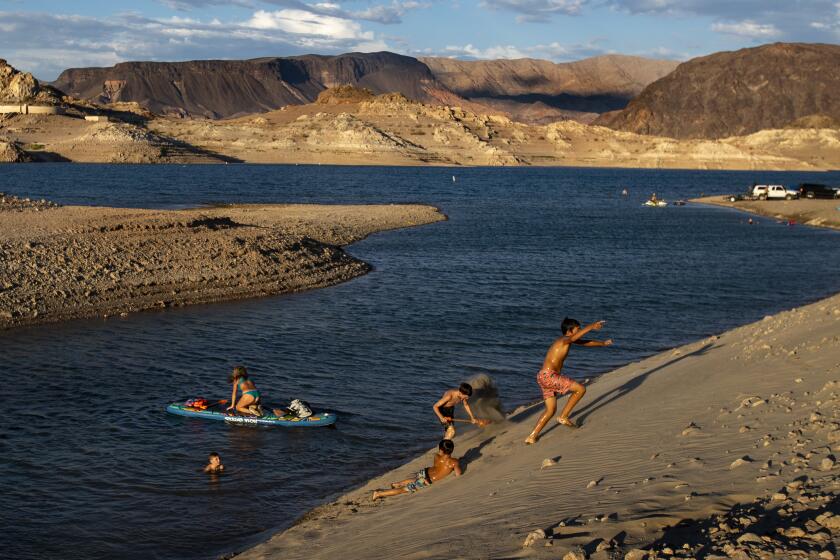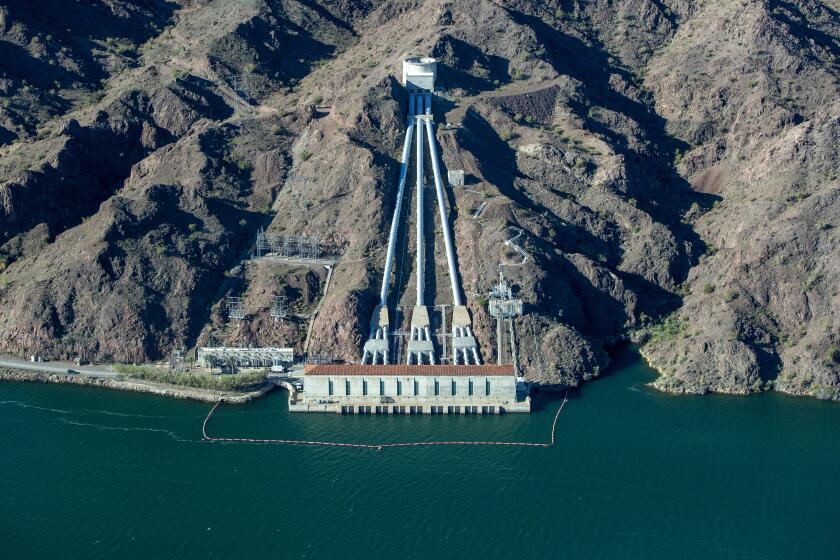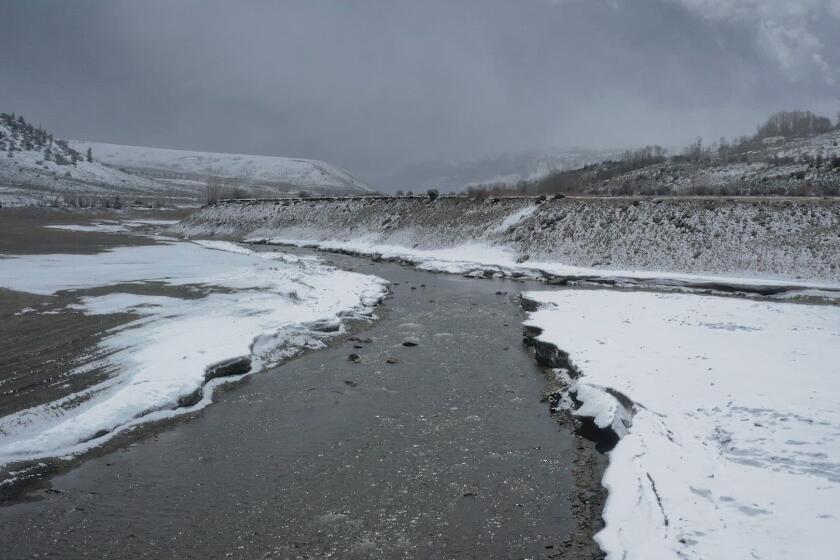
- The Biden administration has announced several options for new long-term rules for managing the Colorado River’s overburdened water supply.
- Federal officials say the alternatives provide paths for seven Western states that have been at odds to move toward a consensus on how to address chronic water shortages.
The Biden administration has announced a range of options for new rules to address chronic water shortages and low reservoir levels on the Colorado River, a vital water source for seven Western states that has dwindled during more than two decades of drought compounded by climate change.
The Interior Department released four alternatives for new long-term rules aimed at dealing with potential shortages after 2026, when the current operating rules expire. The announcement of the proposed alternatives represents one of the Biden administration’s final steps to outline potential paths toward reaching a consensus among California and the six other states, as well as the region’s 30 Native tribes.
“We’re putting forth alternatives that establish a robust and fair framework for a basin-wide agreement,” said Laura Daniel-Davis, acting deputy Interior secretary. “Now really is the time for the basin states and tribes to redouble their work toward a consensus alternative.”
Imperial Valley farmers left fields dry temporarily to help ease the Colorado River’s shortage. The program has led to concerns about the shrinking Salton Sea.
The action advances a federal review process that President-elect Donald Trump’s administration will inherit. But while the change in administration brings a dose of uncertainty, the biggest challenge for the region currently appears to be the stark divisions among the seven states that have emerged in negotiations over the last year.
There have been persistent disagreements about how triggers for water cutbacks should be determined and how those reductions should be apportioned. The disputes have pitted the three states in the river’s lower basin — California, Arizona and Nevada — against the four upper-basin states — Colorado, Utah, Wyoming and New Mexico.
“There certainly are extremely difficult choices and trade-offs to be made, but we believe that there are ample opportunities to create a fair path to solutions that work for the entire basin,” federal Bureau of Reclamation Commissioner Camille Calimlim Touton told reporters in a conference call.
The Colorado River provides water for cities from Denver to San Diego, tribal communities and farmlands across seven states and northern Mexico. The river has long been overallocated, and its reservoirs have declined dramatically since 2000.
The average flow of the river has shrunk about 20% since 2000, and scientists have estimated that roughly half that decline has been caused by global warming driven by the burning of fossil fuels and rising levels of greenhouse gases. The decline in flow is projected to continue to worsen as temperatures climb.
New research examines how much global warming has sapped the Colorado River since 2000. It shows the region has lost more water than Lake Mead can hold.
In recent years, states that depend on the river have adopted a series of incremental water-saving plans in an effort to prevent the Colorado’s reservoirs from falling to critically low levels.
The Interior Department in 2023 began the process of developing long-term operating guidelines to replace rules that expire in December 2026. The agency says an operating plan must be in effect by August 2026.
In its announcement of the alternatives, the Interior Department said the overarching goals include defining water allocations, guiding management of the river and “guarding against the need for the kind of short-term fix” that state and federal officials negotiated to temporarily reduce water use and boost reservoir levels from 2024 through 2026. The Biden administration has recently been funding programs that pay farmers to temporarily reduce water use in exchange for payments.
The Bureau of Reclamation, which manages dams on the river, said the four alternatives include: one that focuses on federal authorities absent new agreements; a second hybrid approach based on federal authorities; a third “cooperative conservation” alternative that would include “incentivizing” water conservation and developing flexible management strategies; and a fourth that would be a hybrid of proposals submitted by the states and tribes.
Also included was a “no action” alternative, as required under federal environmental law.
California, which uses more Colorado River water than any other state, responded with caution and cited the 1922 Colorado River Compact, which allocated the river’s water among the states and established the existing legal framework.
“Federal law requires the Colorado River Basin’s reservoirs be managed in accordance with the Colorado River Compact — the most significant component of which is mandatory deliveries of water from the Upper Basin to the Lower Basin and Mexico,” said J.B. Hamby, California’s Colorado River commissioner. “In order to be valid, any alternative considered must meet this requirement unless the states agree to a compromise otherwise.”
Two groups of states in the Colorado River Basin propose competing long-term plans for addressing chronic water shortages and adapting to climate change.
The 1922 agreement requires the four states of the upper basin to deliver an annual average of 7.5 million acre-feet to California, Arizona and Nevada (over any 10-year period).
Arizona officials have warned that projections show water deliveries might decrease below that required minimum as soon as 2027, which would enable the lower basin states to make a so-called “compact call” and require the upper basin states to meet the requirement by cutting their water usage.
Tom Buschatzke, director of the Arizona Department of Water Resources, discussed that possibility at a meeting this week, saying such a scenario would lead to larger cuts for the upper basin than would occur under a proposal submitted by Arizona, California and Nevada.
Buschatzke said Wednesday that he was a bit disappointed the Bureau of Reclamation chose to create hybrid alternatives rather than presenting a full analysis of the three-state proposal.
Under that proposed plan, California, Arizona and Nevada would make the first round of water cuts to address a shortage, and then would look to the other states to participate if larger reductions are needed, which Buschatzke called a reasonable approach.
“How is the upper basin going to participate with the lower basin?” he said. “That’s the big issue.”
Colorado River in Crisis is a series of stories, videos and podcasts in which Los Angeles Times journalists travel throughout the river’s watershed, from the headwaters in the Rocky Mountains to the river’s dry delta in Mexico.
So far, the states of the upper basin have offered a proposal that includes some conservation efforts but avoids accepting the sort of mandatory cutbacks the other states are calling for.
The current impasse has raised the possibility that an intractable dispute between the states could lead to a fight in the courts. Buschatzke stressed that Arizona doesn’t want a legal battle and that representatives of other states have assured him they do not want litigation either.
“We still have a pretty wide gap between us,” Buschatzke said.
But he said he sees some good provisions in the federal government’s options, and he hopes continued talks “can move the needle forward.”
In a joint statement, California, Arizona and Nevada said they are committed to working toward a “negotiated solution that inherently requires the participation of all water users.”
Democratic Sen. John Hickenlooper of Colorado said the only viable solution is a “collaborative, seven-state plan to solve the Colorado River crisis,” because if the states turn to the courts, “we’ll watch the river run dry while we sue each other.”
Other experts have agreed that turning to lawsuits would create major risks.
“If this issue goes to the courts, the health of the river is going to suffer, because everybody’s attention is going to be directed towards that litigation,” said Jennifer Pitt, director of the National Audubon Society’s Colorado River program.
Pitt said she hopes the states can reach a compromise to manage the river for the 21st century in the face of climate change — now a very “different river than was imagined by the people who wrote the compact.”
The federal government announced the alternatives shortly before Touton was scheduled to meet with state and tribal leaders for the latest in a series of working group discussions.
Water management officials and representatives of states and tribes will also gather in Las Vegas from Dec. 4 to 6 for an annual conference of Colorado River water users, an event that often features negotiating sessions in addition to speeches outlining proposals for reducing demands on the river.
White House National Climate Advisor Ali Zaidi said the struggle is fundamentally about adapting to the effects of climate change. He pointed to recent research by UCLA scientists showing that global warming is a major culprit of the river’s decline, and that higher temperatures have, since 2000, robbed the Colorado River Basin of more than 10 trillion gallons of water, more than the entire storage capacity of Lake Mead, the country’s largest reservoir.
“Just over the last two decades, we’ve seen that deterioration take place,” Zaidi said. “It doesn’t matter what your politics are, climate change still impacts you. We are all lassoed in, banded together, and we’ve got to come up with solutions together.”
Near Las Vegas, Lake Mead is now 33% full. Upstream on the Utah-Arizona border, the water level of Lake Powell, the nation’s second-largest reservoir, stands at 38% of capacity.
Zaidi noted that in 2023 the seven states reached a consensus deal to make substantial short-term reductions in water use.
“We can either remain stuck at an impasse, or we can secure a future for future generations that promises the stability and sustainability of one of our greatest natural resources,” Zaidi said.
The options the federal government has outlined, he said, “provide essentially a platform to reach a consensus path.”











